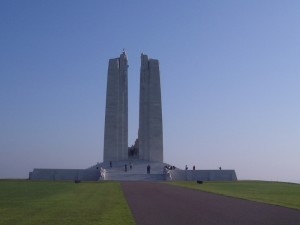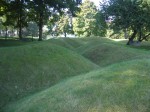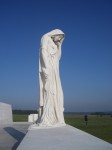I sort of remember hearing about the battle of Vimy Ridge in school and I clearly remember a friend telling me her grandfather had fought there but none of that resonated with me in my teenage years when there were more important things to worry about: the latest Beatles song, new clothes to buy, a babysitting job to find. So, the impact that Vimy Ridge had on me was totally unexpected. Like so many Canadians, I am proud of my country but I don’t wear my patriotism on my sleeve, so to speak. It is more understated. I was, therefore, totally unprepared for how fiercely proud I felt to be a Canadian when I stood before the memorial at Vimy Ridge where, many say, Canada gained its national identity.
For those who don’t know the history, Vimy Ridge is northeast of Arras on the western edge of the Douai Plains in northern France. The ridge rises gradually on its western side, drops off more quickly to the east, and provides a natural unobstructed view for tens of kilometres in all directions.
The ridge fell under German control in October 1914 during the First World War. Over the next year, several unsuccessful attempts were made to recapture it by both French and British forces. In October 1916, the Canadian Corps relieved the British Corps stationed along Vimy’s western slopes and the task of retaking the ridge was given to them under the command of British Lt-Gen Sir J.H.G. Byng.
After careful training and rehearsal, and supported by almost 1000 artillery pieces, the Canadians attacked along a 6.4 km front on 9th April 1917. By April 14th they had gained more ground, more guns, and more prisoners than any previous offensive had done. Canadian casualties mounted to 10,602, of which 3598 were killed.
The Battle of Vimy Ridge was the first occasion where all four divisions of the Canadian Expeditionary Forces participated in a battle as a cohesive formation. Thus it became a Canadian nationalistic symbol of achievement and sacrifice. France gave Canada perpetual use of a portion of land on Vimy Ridge with the understanding that the land be used to establish a battlefield park and memorial. Along with preserved trench lines, there are a number of other memorials and cemeteries contained within the site.
In 1920, the Canadian Battlefields Memorials Commission invited interested parties to submit proposals for a memorial at Vimy Ridge. The successful competitor was Toronto sculptor and designer Walter Seymour Allward. He constructed the memorial on the highest point on the ridge. The memorial contains a large number of features all of which have specific meaning and symbolism. One of the most impressive is the figure of a cloaked young female standing on top of the front wall and overlooking the Douai Plains. The woman has her head bowed, her eyes cast down, and her chin resting in one hand. The saddened figure of Canada Bereft, also known as Mother Canada, is a national personification of the young nation of Canada mourning its dead. The most well known feature of the memorial are the twin white pylons, one bearing the maple leaf for Canada and the other the fleur-de-lis for France, symbolizing the unity and sacrifice of both countries.
The Canadian National Vimy Memorial site is located approximately eight kilometres north of Arras, France, near the towns of Vimy and Neuville Saint-Vaast. The site is one of the few places on the former Western Front where you can see the trench lines of a First World War battlefield and the related terrain in a preserved natural state. The total area of the site is 250 acres (100 ha). Wartime tunnels, trenches, craters and unexploded munitions still honeycomb the grounds of the site, which remains largely closed off for public safety. The site’s rough terrain and unearthed unexploded munitions make the task of grass cutting too dangerous for human operators. Instead, sheep graze the open meadows of the site.
The site’s interpretive centre helps visitors fully understand the Vimy Memorial, the preserved battlefield park and the history of the Battle of Vimy within the context of Canada’s participation in the First World War. Visitors can also take a tour of the tunnels where, on that fateful morning in April 1917, thousands of troops awaited to storm the Germans. In one room, a particularly poignant feature is a small maple leaf that one soldier carved into the soft rock while he was waiting the call. I have toured the tunnels twice and learned different details about the battle each time. For example, the second visit did not include seeing the room where the maple leaf is carved but included seeing the officers quarters.
The Canadian National Vimy Memorial and the Beaumont-Hamel Newfoundland Memorial, also located in this region of France, comprise close to 80 percent of conserved First World War battlefields in existence and between them receive over one million visitors each year They are the only two National Historic Sites of Canada located outside of the Canada.
Every Canadian should try to make at least one visit to Vimy Ridge to appreciate truly the sacrifice as well as the innovation made by Canadians there over 95 years ago.


















